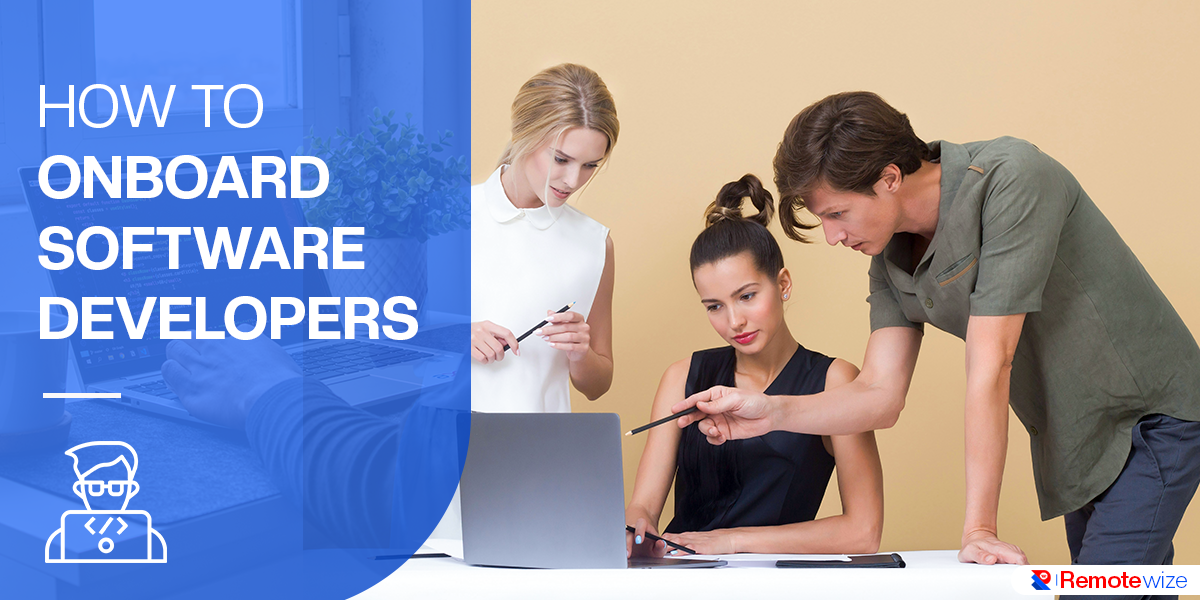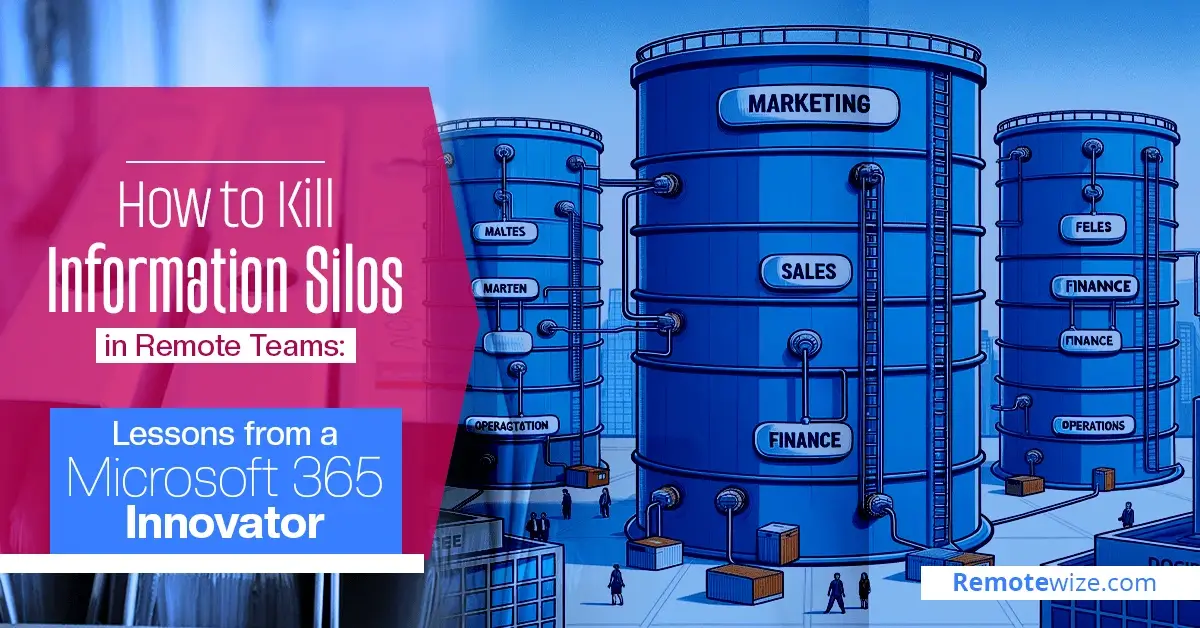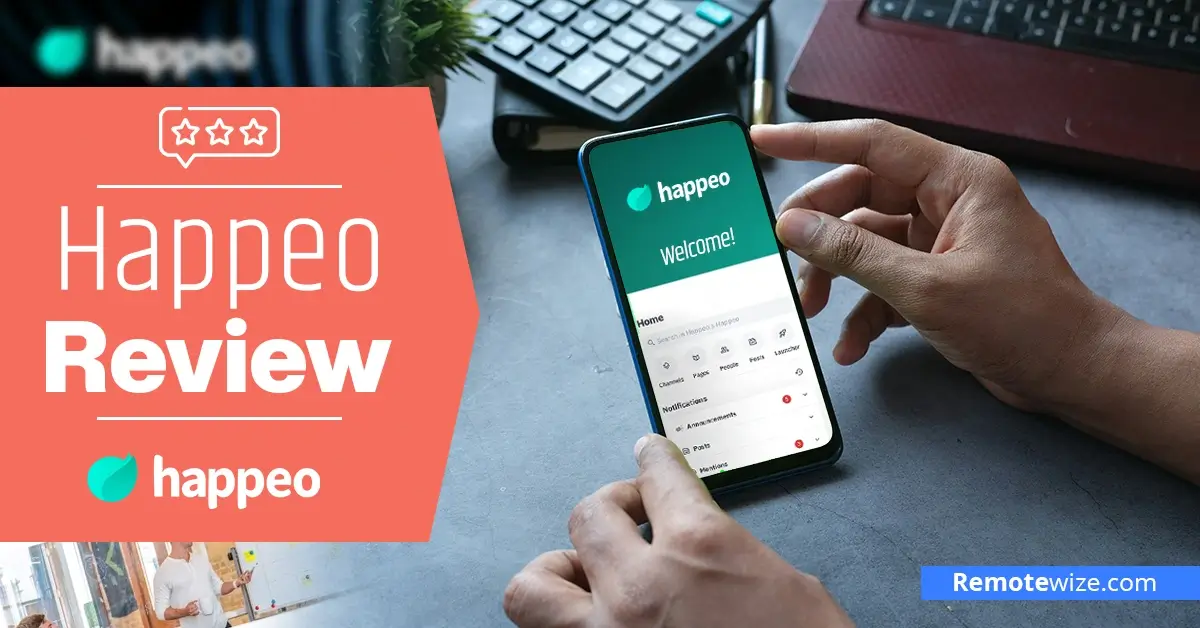Believe it or not, more than 50% of new hires in the U.S. think about quitting within their first three months. If a newly hired software developer quits or turns out to be unfit for the role, it’s likely due to a flawed developer onboarding process.
About 80% of poorly onboarded hires plan to quit, especially if they work remotely and involve technical jobs. On the flip side, companies with effective onboarding see an 82% improvement in new hire retention and a 70% boost in productivity.
Once you find software developers for your startup, onboarding them remotely can be tricky and challenging since there is no in-person communication. However, with industry-leading onboarding practices, you can equip your new developers with the required knowledge and confidence to start strong.
This article will walk you through the four stages of onboarding remote software developers.
So, let’s jump right in!
1. Pre-Onboarding New Developers Checklist
It doesn’t matter whether you onboard employees remotely or in person; the basic principles of hiring remain the same: start strong with excellent pre-onboarding. It helps you preplan the first day of onboarding.
Follow the pre-onboarding software developer checklist to make things easier for new hires and your organization:
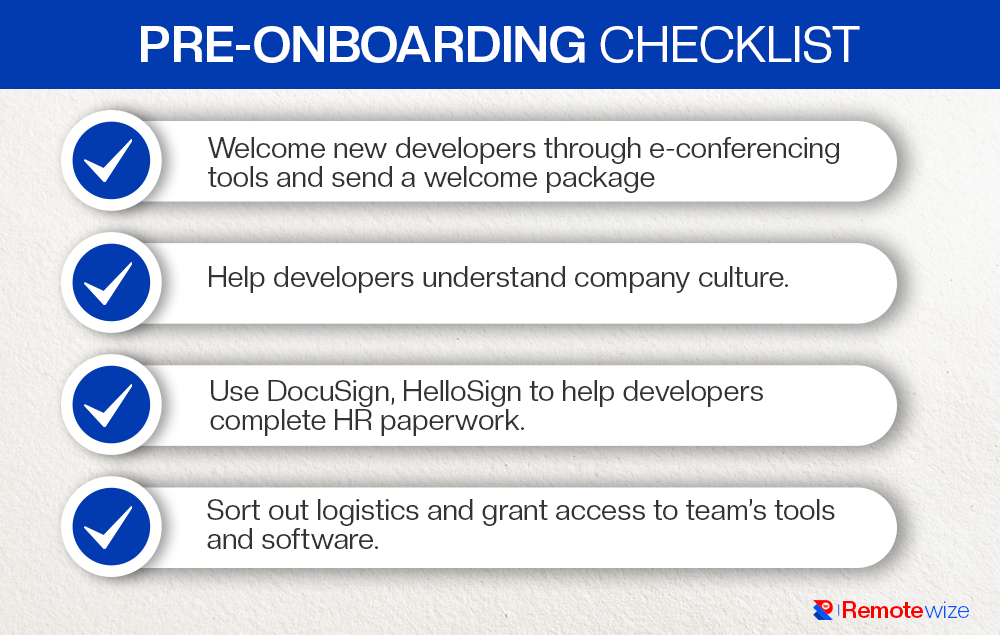
Welcome Your New Developer
The first step of a software developer onboarding checklist is to warmly welcome the new employee through e-conferencing platforms like Zoom or Google Meet.
First days can be nerve-wracking, so a virtual call is a fantastic way to answer any concerns they might have.
During this call, make sure to cover key points, like:
- Your new employee’s initial responsibilities
- Regular working hours
- Introduce their team
- Coding standards
- Your expectations
- The collaboration and communication tools you’ll use
After the virtual call, share the developer onboarding checklist documentation. The new hire can read the document to understand it thoroughly. It’s a great way to ease them into their new role.
Help the Developer Understand Company Culture
According to one report, over 30% of Americans would reject a perfect-fit job if the company culture clashes with their values.
Organizational culture is the personality of a company. It is your shared goals, values, practices, and attitudes. So, make sure to include it in your software developer onboarding.
It’s helpful if you get your new hires acquainted with the company culture so they perform better.
To help developers understand your organizational culture, share:
- Your online employee handbook
- Presentation on organizational values, vision, and mission
- Videos from all-hands meetings
It’s also beneficial for new developers to meet with your company leadership one-on-one. For example, your CEO can discuss the company’s history, long-term goals, and leading products or services.
Help Developers With HR Paperwork
Many software developers and engineers want to code right away instead of spending their first days signing paperwork. An effective way to save time is to complete the documentation before the first day of work, i.e., orientation.
Alternatively, your new developer can digitally sign legal documents, including employment contracts, using e-signature software or tools like DocuSign and HelloSign.
Sort Out Logistics
Make sure to plan ahead if you want to send the new hire computers and the rest of the equipment for their remote working station. Order equipment and tools a few weeks in advance to ensure they arrive on time for the new developer’s first day.
Grant Access to Tools & Software
Ensure your new developer starts their first day without confusion about how to access the work systems. You can do this by providing them with login details and invitations to project management systems, chat apps, email, and other tools.
Prepare a manual that lists all the important tools, their function, and login credentials. Send this manual as an email or send them a Post-it copy to stick it on their work desk/wall.
Send A Welcome Package
Another optional thing on your developer onboarding checklist is sending a welcome package. It can boost your new hire’s morale. Send it before their start date and include the following:
- A welcome letter (from either the CEO or the HR)
- Branded merchandise like T-shirts and coffee mugs
- Personalized gifts such as headphones, an internet device, or gift cards
2. First-Day Developer Onboarding Checklist
Introductions play a crucial role in onboarding, especially for remote software developers. Create a welcoming atmosphere since they may not get as many chances to introduce themselves on their first day.
Let’s see how you can make your new developer’s first day a blast despite being remote:
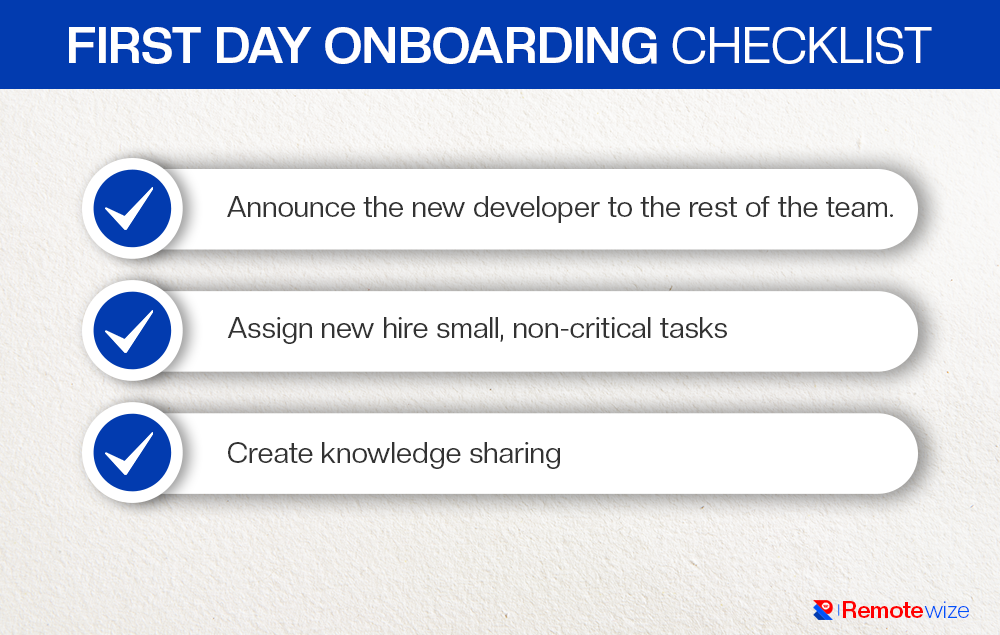
Share New Employee Announcement
When you recruit a new remote employee, they may not feel confident reaching out to the team on their own. You can make your recently hired software developers feel excited and welcome by sending a new hire announcement.
A short message in the #general channel on Slack (or any communication platform your company uses) is perfect.
Hi everyone!
It’s always a good day when I can share exciting news with you all — we are welcoming @Sara to the Remotewize Engineering team! :tada:
Sarah, we would love to learn a little bit about you! Please share with us:
- Where you are based
- Fun fact — anything you’d like to share! (e.g. a hobby, something you’ve recently started doing and enjoy, a fun skill you have, something upcoming you’re looking forward to, etc.)
In addition to sending the developer’s name, throw in some fun facts as well as their birthplace and current residence. This way, all team members can greet the newcomer and extend a warm welcome. This introduction is an excellent method for remote team members with common hobbies to connect quickly.
Give Your New Developer Small, Non-Critical Tasks
Start the new developer off on the right foot by giving them a simple and clear task. Maybe they could work on a small, specific feature.
Doing right, it boosts their confidence and enthusiasm for the job. Plus, they’ll get a firsthand look at your company’s development process, from ‘code review’ to deploying the final product.
To ease any initial stress or anxiety, consider assigning lighter tasks during their first few weeks on the job.
Create Knowledge Sharing
To help your team succeed, make sure they have the right information by setting up knowledge sharing. A cool way to do this is using wikis that have everything a new team member needs to know.
Include tool guides, contact lists, software tutorials, and common bugs. In short, document everything needing step-by-step instructions to ditch those lengthy employee orientation meetings.
3. First-Week Software Developer Onboarding Checklist
The software developer onboarding doesn’t end on the first day. In fact, it should continue in the first few weeks – up until a month. should exist from day one. Use the first week of onboarding to have more and more
There are a few things you need to work out, such as building confidence and trust, which communication – whether in terms of meetings or a buddy.
Here’s what the first week of onboarding looks like:
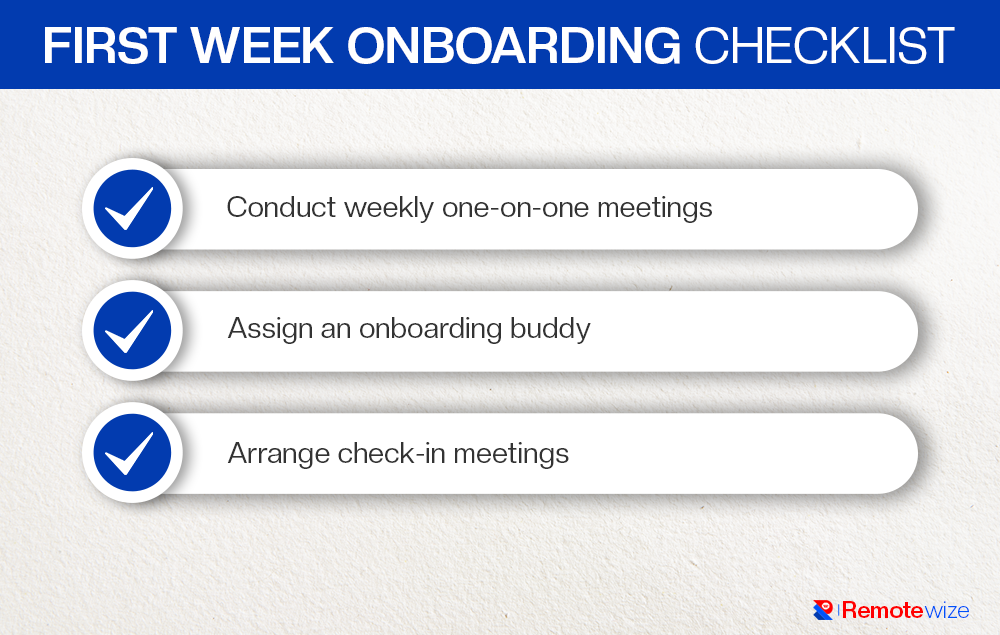
Have Weekly One-On-One Meetings
Build trust with new hires through weekly one-on-one video meetings. Use them to share feedback, address challenges, celebrate milestones, and more.
As your software developers settle in, these meetings may become less frequent but are vital for a positive first impression. Don’t forget to fill in any missing information and ask how you can support their success.
Arrange Check-In Meetings With A Tech Team
Add daily check-in meetings to your software developer onboarding checklist. During these sessions, you can catch up on completed tasks, daily activities, and project updates.
This helps the new developer stay informed about crucial team events and fosters a stronger connection with team members.
Assign Your New Developer A Buddy
A smart thing you can do is to pair your new developers with junior developers rather than senior ones. That’s because junior software developers have fresh onboarding experience and can offer valuable advice to newcomers.
Another option is to designate a mentor for the new hire. They will be their main contact for work and culture-related matters for at least 1-2 months.
Instead of junior developers fixing your new recruit’s problems, think about incorporating pair programming sessions. They help developers share knowledge and collaborate in problem-solving.
4. First-Month Developer Onboarding Checklist
During the first month of remotely onboarding new developers, your focus should be to motivate them so they maintain their day-one and first-week enthusiasm.
Listed below are a few things you can do:
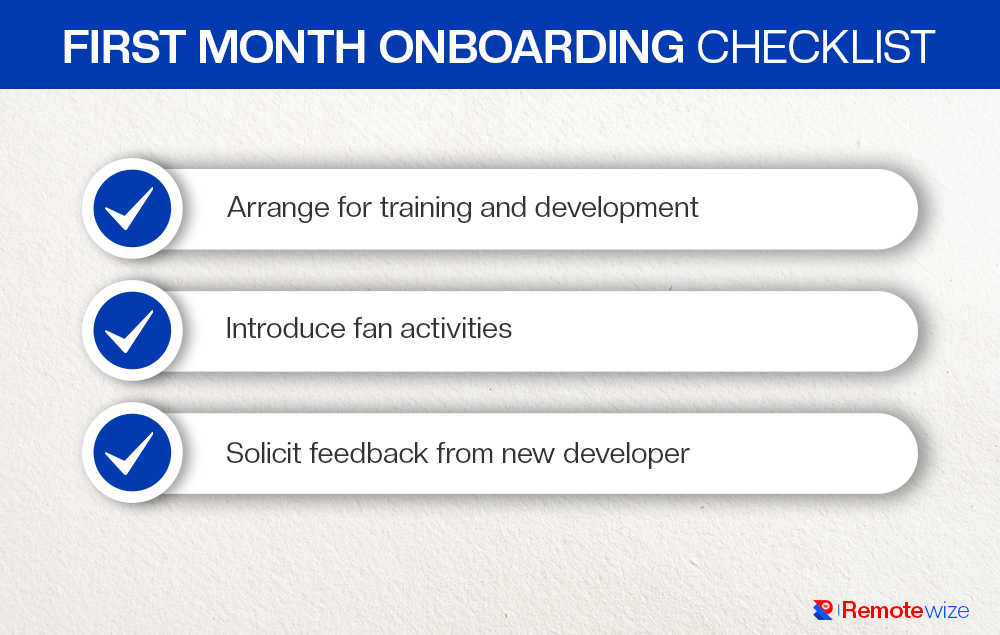
Arrange Training
Shift your focus from hiring and onboarding to training and development to enhance employee retention.
Adequate training is crucial for remote employees. You should arrange job shadowing or virtual training sessions alongside online reading and video materials to help new developers acclimate to their roles.
Make Way for Fun
You can spice things up for remote employees by incorporating fun activities, like using the ‘Donut integration for Slack. This tool randomly pairs people across the company for regular video calls or discussions in their private Slack channel.
In addition, you can conduct team-building activities bi-monthly to foster a comfortable environment for employees to share opinions, even jokes.
Collect Feedback
In any manager- employee relationship, providing feedback to software developers is vital. Equally important is hearing what the remote software developer wants to say about your management.
While your remote software developer onboarding might be good, there’s always room for improvement. So, ask remote developers for feedback to improve the onboarding process further.
You can ask whether they encountered any frustration or confusion during onboarding. This will help you identify major blocks and provide additional support where needed.
Onboard Software Developer More Effectively
Take your new remote developers through each stage to prevent accidental damage to the production database on their first day.
Ensure to provide the necessary tools, assign initial tasks for the first few weeks, and gather feedback to continuously enhance the onboarding process. Don’t forget the relationship building and human interaction aspects of work.
Remember, your focus should be on making new developers feel respected, included, and supported. Follow the guide to the T to onboard remote developers effortlessly.
Happy onboarding!
Frequently Asked Questions (FAQs)
How to Address Time Zone Differences During Remote Onboarding?
You can easily address time zone differences by scheduling meetings at times convenient for all team members and rotating meeting times when possible. In addition, you can use asynchronous communication methods such as shared documents and messaging platforms.
What Cybersecurity Measures Should Be Implemented for Remote Onboarding?
According to one report, over 2,200 cyberattacks happen every day. Considering this, you have to ensure secure access to company systems with strong authentication methods. Educate remote developers on cybersecurity best practices and provide VPNs for a secure connection.
How Long Does Developer Onboarding Take?
Whether you’re hiring junior or senior developers, their onboarding time depends more on interpersonal skills than technical prowess. Typically, it can take you anywhere from a few days to months.

